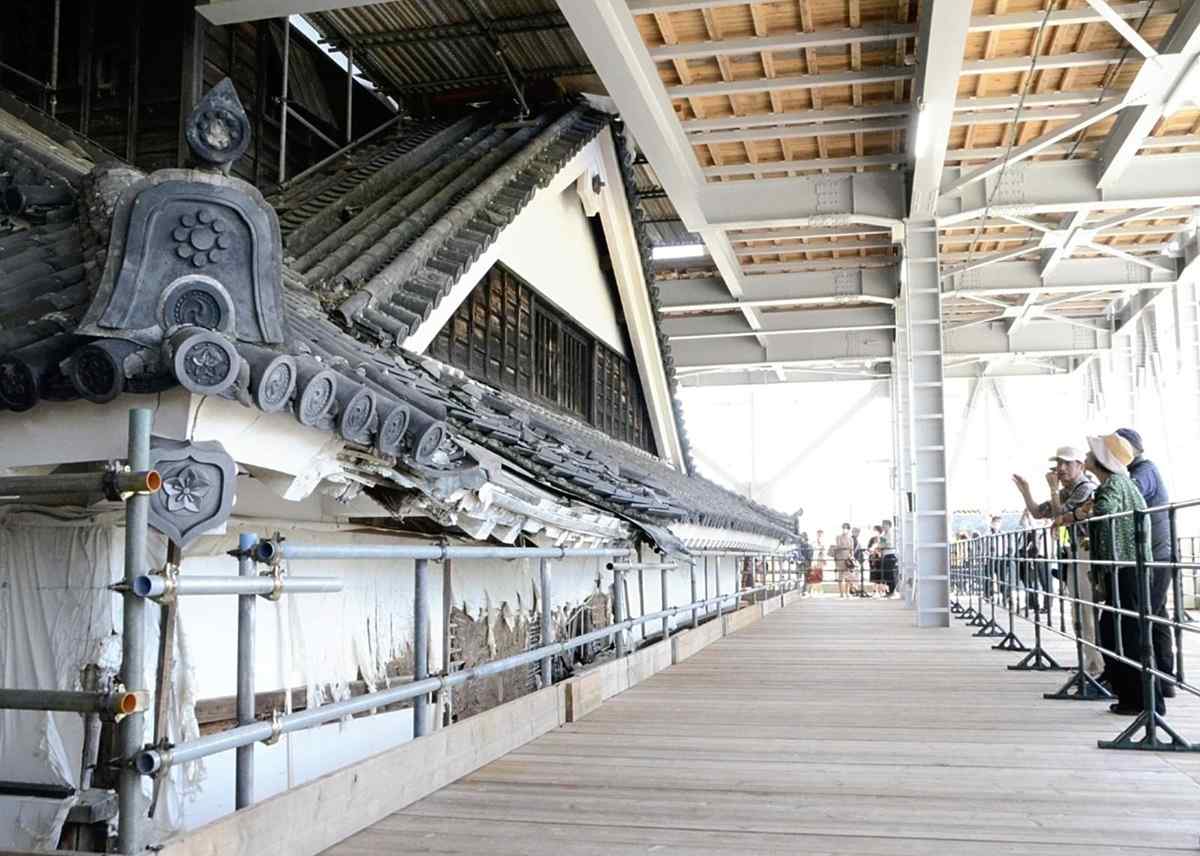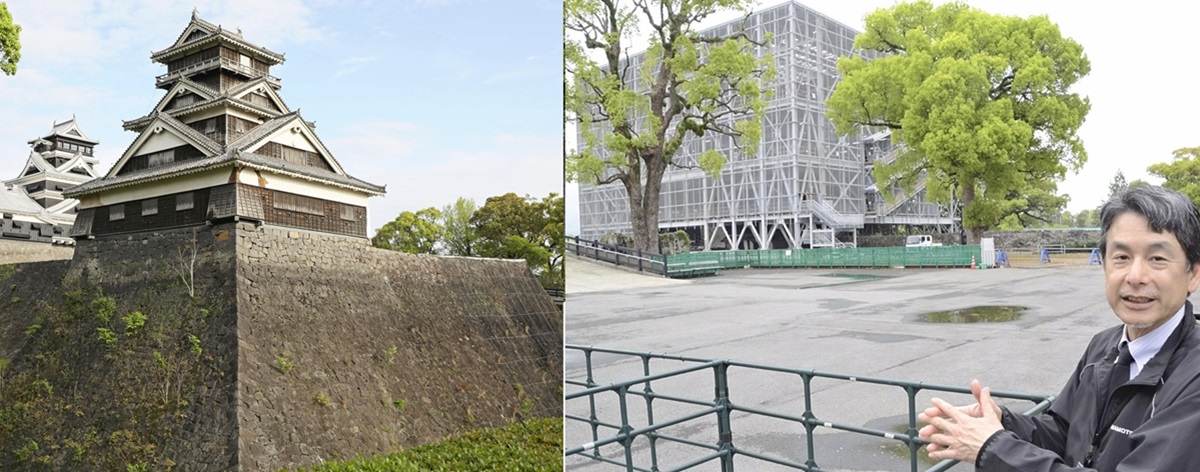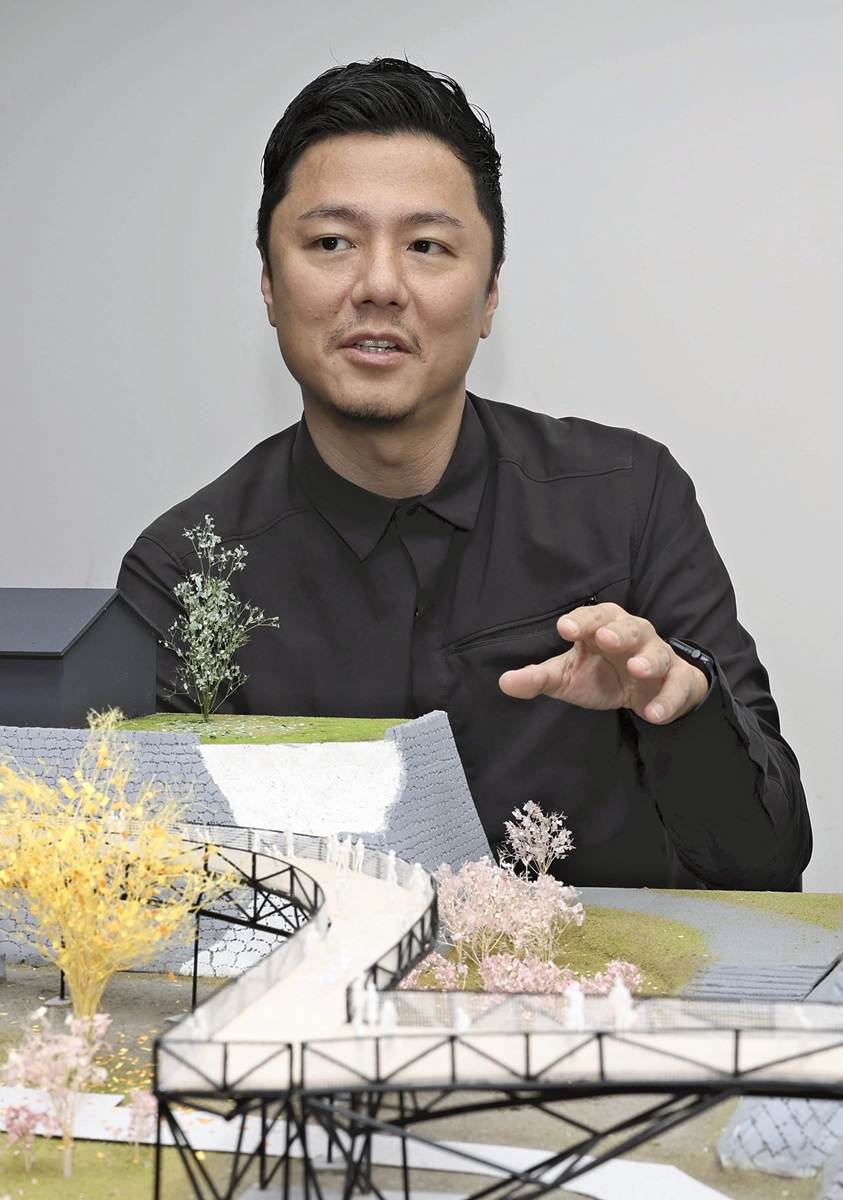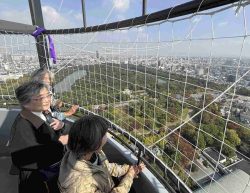Kumamoto: Open Restoration of Castle Draws Tourists; Number of Visitors Gaining on Previous Levels

Visitors look at Uto-Yagura, which still bears the scars of earthquake damage, in Kumamoto on April 14.
12:42 JST, April 27, 2024
KUMAMOTO — Kumamoto Castle, which was heavily damaged in the 2016 Kumamoto Earthquake, has been getting more and more visitors thanks to its “visible restoration” that is expected to last decades.
In fiscal 2023, the number of visitors reached 1.35 million people, about 350,000 more than the previous year and recovering to nearly 80% of the pre-quake level. Eight years after the earthquake that devastated the prefecture, an official involved in the restoration said, “We hope people will keep being interested in the region.”
The Kumamoto municipal government has begun special openings of the castle’s Uto-Yagura tower, which is still under restoration work, about once a month starting in April.

Left: The Uto-Yagura tower before being covered with scaffolding in 2021. Right: Yasuhiro Iwasa, an official of the municipal Kumamoto Castle General Office, shows the Uto-Yagura tower surrounded by scaffolding
Uto-Yagura is designated as a national important cultural property. It is said to have been built in the Keicho era (1596-1615) when Kumamoto Castle was originally constructed. The tower is also called the third keep of the castle after the main keep and its attached smaller keep. Uto-Yagura is a five-story building above ground with a basement level. In the earthquake, it suffered damage in more than 40 locations, including broken pillars and damaged outer walls. While the tower escaped total destruction, the entire structure was tilted.
In January, dismantling work of the tower began and it is completely covered with scaffolding. Restoration work is scheduled to be completed in fiscal 2032. The municipal government has begun to allow visitors inside the scaffolding on the second Sunday of every month. It can also be visited from May 3 to 5 during Golden Week.

“We hope that visitors will look closely at things like the collapsed walls, cracked kawara tiles and the current state of the tower, which you can see only now,” said Yasuhiro Iwasa, the chief official responsible for restoration at the municipal Kumamoto Castle General Office. “We will continue efforts to deepen people’s understanding of the restoration process while passing along records of the damage done.”
Only 20% restored
Thirteen of Kumamoto Castle’s structures are national important cultural properties and all were either damaged or destroyed by the earthquake. Twenty structures, including the main keep, were reconstructed in later periods and were also affected by the earthquake. The castle’s stone walls are known for their “Mushagaeshi” (warrior-repelling) structure that gradually grows steeper higher up the walls. Nearly 10% of the walls, about 8,200 square meters, collapsed in the earthquake.
The main keep’s repair work was done first and completed 2021 as a symbol of the restoration. However, the entire castle is not expected to be fully restored until fiscal 2052, with just over 20% of the scheduled work having been completed by the end of March 2022.
As entry to the castle is restricted due to the restoration work, a special observation path was built and has played a major part in the tourism revival. The five to seven-meter-high elevated path was built in 2020, allowing visitors to observe the conditions up close without interrupting restoration work or blocking construction vehicles.

The special observation path from which visitors can see areas with entry restrictions in Kumamoto on April 8
The construction of such a path to allow tourism while continuing restoration was unprecedented in the country and was a difficult project, according to Yuzuru Tsukagawa of the Kyushu branch of Nihon Sekkei Inc. in Fukuoka, who was involved in the design of the path.
Since valuable underground foundations remained at the castle, the ordinary piling construction method could not be used. Laying wire mesh on the ground and paving the ground with stones, Tsukagawa’s team built a concrete foundation on top of that. He adopted a special structure in which the path was supported by columns and decided the 350-meter observation route while taking care to cut down as few trees as possible. According to Tsukagawa, the process was like threading a needle.
Over 1.77 million people visited castle areas that charge entrance fees in fiscal 2015. While the number declined due to the earthquake and the COVID-19 pandemic, it has been increasing in recent years thanks to the completion of the special observation path and the opening of the main keep.

Yuzuru Tsukagawa speaks about the special observation path in Fukuoka on April 8.
“Kumamoto Castle succeeded in opening to the public during restoration work while taking measures to protect cultural properties and ensure the safety of visitors,” said Toshitaro Minomo, a professor emeritus of landscape architecture at the Tokyo University of Agriculture who was involved in the compilation of the castle’s restoration plan. “Many disaster-affected areas can refer back to the experience of Kumamoto.”
Related Tags
"Features" POPULAR ARTICLE
-

Sanrio to Open Museum in Yamanashi Pref. Dedicated to Founder, Exhibits Include Hello Kitty, Other Characters
-

Autumn Foliage Surrounds Visitors to Tokyo’s Showa Kinen Park
-

My Daughter No Longer Speaks to Me, But I Want to See Her and My Grandchild
-

Kumamoto: Public Bath Refurbished as Library Where You Can Chat, Take Photos
-

Japanese Macaques Enjoy Bathing in Hot Spring in Hokkaido
JN ACCESS RANKING
-

Keidanren Chairman Yoshinobu Tsutsui Visits Kashiwazaki-Kariwa Nuclear Power Plant; Inspects New Emergency Safety System
-

Imports of Rare Earths from China Facing Delays, May Be Caused by Deterioration of Japan-China Relations
-

University of Tokyo Professor Discusses Japanese Economic Security in Interview Ahead of Forum
-

Japan Pulls out of Vietnam Nuclear Project, Complicating Hanoi’s Power Plans
-

Govt Aims to Expand NISA Program Lineup, Abolish Age Restriction

























